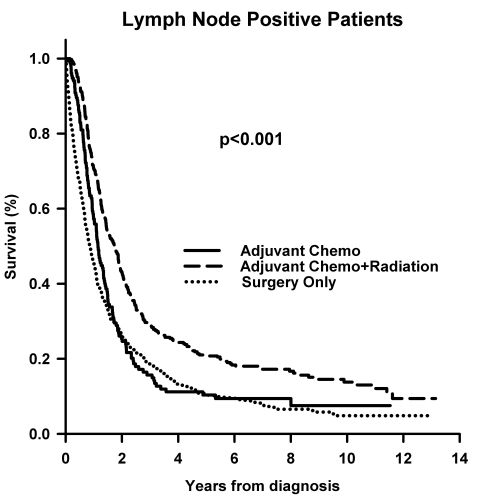
|
 |
Back to 2015 Annual Meeting Program
Patients With Resected Gallbladder Cancer Demonstrate Improved Survival With Adjuvant Therapy
Richard S. Hoehn*, Koffi Wima, Audrey Ertel, Alexandra Meier, Syed Ahmad, Shimul a. Shah, Daniel E. Abbott
Surgery, University of Cincinnati, Cincinnati, OH
OBJECTIVES: The management of resected gallbladder cancer (GBC) and use of adjuvant therapy remains unclear. Using a comprehensive national cancer registry, we sought to correlate patient demographic, tumor, and treatment-specific characteristics with survival following resection for GBC.
METHODS: The American College of Surgeons National Cancer Data Base (NCDB) was used to identify patients with resected GBC (pathologic stage 1-3) from 1998-2006 (n=6,690). We compared three groups: surgery only (S, 78.6%), surgery plus adjuvant chemotherapy (AC, 6.2%), and surgery plus adjuvant chemotherapy and radiation therapy (ACR, 15.1%). Univariate and Cox regression analyses were used to determine the influence of patient demographics, provider characteristics, and tumor-specific variables on receipt of adjuvant therapy and overall survival.
RESULTS: Patients who received adjuvant therapy were younger (median age- S: 74, AC: 67, ACR: 66), had private insurance (S: 25.4%, AC: 36.0%, ACR: 41.7%) and earned a higher income (>\,000- S: 35.9%, AC: 39.6%, ACR: 39.2%) (all p<0.05). Patients receiving adjuvant therapy were also more likely to have had positive lymph nodes (S: 39.8%, AC: 71.2%, ACR: 63.1%), positive surgical margins (S: 13.1%, AC: 31.3%, ACR: 19.7%), and stage 3 disease (S: 19.9%, AC: 30.7%, ACR: 29.6%) (all p<0.001). Patients receiving ACR had a better median overall survival (1.77 years, 95%CI 1.65-1.95) than patients receiving AC (1.03 years, 95%CI 0.89-1.16) or surgery only (1.50 years, 95%CI 1.42-1.59). This survival difference was even greater for node-positive patients (Figure 1) (S: 0.86 years, 95%CI 0.78-0.96; AC: 1.15 years, 95%CI 0.99-1.35; ACR: 1.73 years, 95%CI 1.45-1.90). On multivariate analysis, ACR was associated with improved survival in all patients (HR: 0.84, 95%CI: 0.76-0.92) and even more so in node-positive patients (HR: 0.63, 95%CI: 0.54-0.74).
CONCLUSION: National practice patters demonstrate that younger, privately insured high-risk patients with resected GBC (positive margins, node positive) are more likely to receive adjuvant therapy, and that ACR is associated with improved survival. These data demonstrate variation in the treatment of GBC, and argue for development and institution of standard practice patterns for patients with this aggressive malignancy.

Back to 2015 Annual Meeting Program
|


